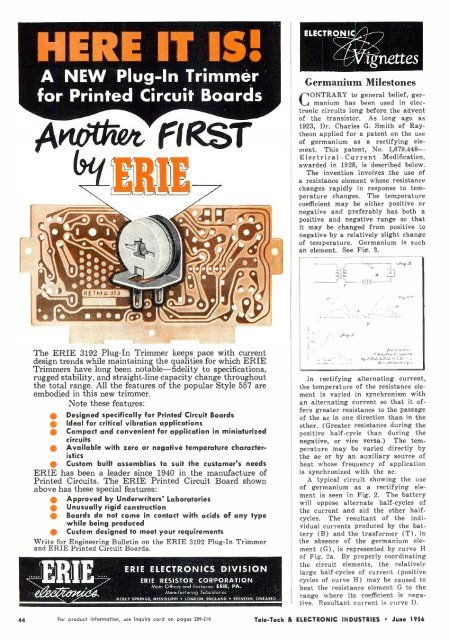TELE-TECH & - AmericanRadioHistory.Com
TELE-TECH & - AmericanRadioHistory.Com
TELE-TECH & - AmericanRadioHistory.Com
Create successful ePaper yourself
Turn your PDF publications into a flip-book with our unique Google optimized e-Paper software.
....<br />
f<br />
HEREIT1F!<br />
A NEW Plug -In Trimmer<br />
for Printed Circuit Boards<br />
AikwMIrFI RSÎ<br />
('iot<br />
ELECTRONIC<br />
Vignettes<br />
Germanium Milestones<br />
to general belief, ger-<br />
CONTRARY manium has been used in electronic<br />
circuits long before the advent<br />
of the transistor. As long ago as<br />
1923, Dr. Charles G. Smith of Raytheon<br />
applied for a patent on the use<br />
of germanium as a rectifying element.<br />
This patent, No. 1,679,448 -<br />
Electrical - Current Modification,<br />
awarded in 1928, is described below.<br />
The invention involves the use of<br />
a resistance element whose resistance<br />
changes rapidly in response to temperature<br />
changes. The temperature<br />
coefficient may be either positive or<br />
negative and preferably has both a<br />
positive and negative range so that<br />
it may be changed from positive to<br />
negative by a relatively slight change<br />
of temperature. Germanium is such<br />
an element. See Fig. 3.<br />
The ERIE 3192 Plug -In Trimmer keeps pace with current<br />
design trends while maintaining the qualities for which ERIE<br />
Trimmers have long been notable -fidelity to specifications,<br />
rugged stability, and straight -line capacity change throughout<br />
the total range. All the features of the popular Style 557 are<br />
embodied in this new trimmer.<br />
Note these features:<br />
Designed specifically for Printed Circuit Boards<br />
Ideal for critical vibration applications<br />
<strong>Com</strong>pact and convenient for application in miniaturized<br />
circuits<br />
Available with zero or negative temperature characteristics<br />
Custom built assemblies to suit the customer's needs<br />
ERIE has been a leader since 1940 in the manufacture of<br />
Printed Circuits. The ERIE Printed Circuit Board shown<br />
above has these special features:<br />
Approved by Underwriters' Laboratories<br />
Unusually rigid construction<br />
Boards do not come in contact with acids of any type<br />
while being produced<br />
Custom designed to meet your requirements<br />
Write for Engineering Bulletin on the ERIE 3192 Plug -In Trimmer<br />
and ERIE Printed Circuit Boards.<br />
ERIE ELECTRONICS DIVISION<br />
ERIE<br />
RESISTOR CORPORATION<br />
Mom Offices and Factories ERIE, PA.<br />
Manufacturing Subsidiaries<br />
HOLLY SPRINGS, MISSISSIPPI LONDON, ENGLAND TRENTON, ONTARIO<br />
- .<br />
/iu .a.,.<br />
/hnNs<br />
////u. vs..,<br />
.. .<br />
. .<br />
,..<br />
In rectifying alternating current,<br />
the temperature of the resistance element<br />
is varied in synchronism with<br />
an alternating current so that it offers<br />
greater resistance to the passage<br />
of the ac in one direction than in the<br />
other. (Greater resistance during the<br />
positive half -cycle than during the<br />
negative, or vice versa.) The tern -<br />
perature may be varied directly by<br />
the ac or by an auxiliary source of<br />
heat whose frequency of application<br />
is synchronized with the ac.<br />
A typical circuit showing the use<br />
of germanium as a rectifying element<br />
is seen in Fig. 2. The battery<br />
will oppose alternate half -cycles of<br />
the current and aid the other half -<br />
cycles. The resultant of the individual<br />
currents produced by the battery<br />
(B) and the trasformer (T), in<br />
the absence of the germanium element<br />
(G), is represented by curve H<br />
of Fig. 2a. By properly coordinating<br />
the circuit elements, the relatively<br />
large half -cycles of current (positive<br />
cycles of curve H) may be caused to<br />
heat the resistance element G to the<br />
range where its coefficient is negative.<br />
Resultant current is curve D.<br />
44 For product information, use inquiry cord on pages 209 -210<br />
Tele -Tech & ELECTRONIC INDUSTRIES June 1956
















